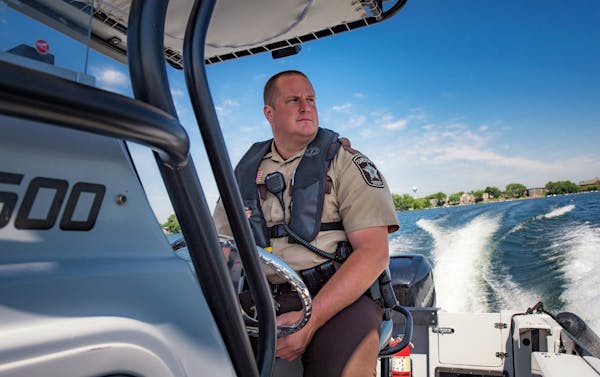As thousands of people crowd Minnesota lakes and rivers for the unofficial opening of the boating season this weekend, water patrols are out in full force to remind them of a new law sparked by a young girl's death three years ago.
The state is the first in the nation to require some boats to install carbon monoxide detectors to catch buildups of the gas before it turns deadly.
"If it can save one life, it's worth it," Darvin Kroeger said after he was stopped on Lake Minnetonka on Sunday.
He already had carbon monoxide warning stickers but didn't know his cabin cruiser also needed a detector. The new law, which went into effect this month, is named Sophia's Law after Sophia Baechler, 7, of Edina, who died on Lake Minnetonka in 2015 when carbon monoxide leaked from a hole in an exhaust pipe on her family's boat.
While no carbon monoxide-related boat fatalities have been reported since then in Minnesota, a 24-year-old Wisconsin woman died from carbon monoxide poisoning in 2017 on the St. Croix River.
Carbon monoxide poisoning can happen when gas builds up from an idling motor, generator or faulty motor exhaust system. It's a hidden danger because the toxic gas is odorless and invisible. Symptoms include headache, dizziness, weakness, nausea, vomiting, chest pain and confusion.
Minnesota has more than 540,000 motorboats. And all boats with an "enclosed accommodation area" — sleeping areas, galleys with sinks, toilet compartments — must have a marine-certified carbon monoxide detector and post three warning stickers about carbon monoxide poisoning. The state Department of Natural Resources estimates 8,000 boats are affected by the rule.
While some new boats already come with the detectors, owners of older boats will have to retrofit them to comply with the law, which has already won national acclaim. It also requires all motorboats with "an enclosed occupancy space" — smaller areas that a person might enter — to have the three carbon monoxide poisoning warning stickers. An estimated 45,000 boats are affected.
The new law was supposed to take effect last year but got postponed a year until May 1.
At West Marine in Minnetonka, the detectors have flown off the shelves with boaters preparing for the start of the new season. Salesman Greg Zimmer said Sunday the store sold about 1,000 detectors in the past month. Most boaters seem to know about the law and the need for the detectors, which he said cost an average of $100.
"It really hasn't been an issue, except for the sticker shock," he said. "I think it will be a springboard for other states."
A half-hour before sliding his boat into Lake Minnetonka for the first time this year, Jorj Ayaz of Mound installed his new detector.
"It's probably the best $130 I spent," he said. "It was the right thing to do."
After hearing about Baechler's death in 2015, he bought a residential carbon monoxide detector for his boat. But since the new law specifies a marine-certified one, he threw it out and bought one that complied with the law.
"What a life-altering thing with something that's supposed to be fun," he said of the girl's death.
On Baechler's family's boat, carbon monoxide leaked from a hole in the exhaust pipe after a muskrat had chewed through it, creating a hole underneath a mattress area where the second-grader was resting. The family had been on the boat for only 35 minutes. In 2013, two men fishing on Lake of the Woods died from carbon monoxide caused by a faulty exhaust system.
The DNR advises boaters not to leave motors idling or generators running while anchored or docked, not to sit on the rear swim deck while the motor is running, and to stay back at least 20 feet when water skiing or tubing. Motors and exhaust systems should be maintained each year.
Authorities from the DNR and Hennepin County's Water Patrol said they will be focusing on educating boaters on the new law. And with ice-out delayed this year, leaving some lakes ice-covered until earlier this month, boaters should also be aware of the dangers of cold water.
As of May 22, three people have died on waterways in Minnesota, the same number of deaths this time last year, which ended with 12 people killed on lakes and rivers. Officials also warn that more boaters are driving distracted by smartphones and other devices, causing a surge in boating accidents.
On Lake Minnetonka, the Twin Cities' largest lake, authorities were out patrolling Sunday as jet skiers and boats of all sizes zoomed by in the hot sun.
"This has been a weird year," said Kroeger, of Burnsville. "A month ago we had snow on the ground and now it's 90."
Kelly Smith • 612-673-4141

Trail section at one of Minnesota's most iconic spots closing for rehab

Will 'shotgun only' zone for deer in southern Minnesota be abolished?

Four Minnesotans catch salmonella in outbreak linked to basil sold at Trader Joe's

